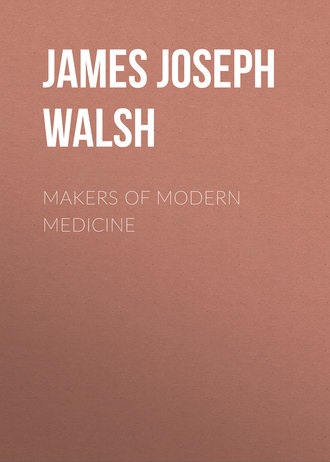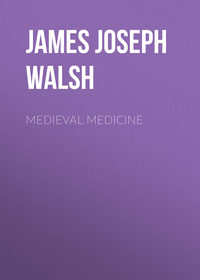 полная версия
полная версияMakers of Modern Medicine
MORGAGNI, THE FATHER OF PATHOLOGY
Let us then blush, in this so ample and so wonderful field of nature (where performance still exceeds what is promised), to credit other men's traditions only, and thence come uncertain problems to spin out thorny and captious questions. Nature herselfe must be our adviser; the path she chalks must be our walk; for so while we confer with our own eies, and take our rise from meaner things to higher, we shall at length be received into her closet-secrets.
--Preface to Anatomical Exercitations concerning the Generation of Living Creatures, 1653. William Harvey."VIR INGENII, MEMORIAE, STUDII, INCOMPARABILIS."
–-HALLER.
In 1894, when the International Medical Congress met at Rome, Prof. Virchow of Berlin, the greatest living pathologist at the time, was asked to deliver the principal address. He chose as his subject John Baptist Morgagni, the distinguished Italian physician and original investigator of the eighteenth century, whom he hailed as the Father of Pathology. No medical scientist of the nineteenth century was in a better position than Virchow to judge who had been the founder of the science for which he himself did so much. Virchow besides, through long and faithful study of the history of medicine, knew well whereof he spoke. In pathology especially modern medicine has made its sure advances, so that Morgagni's ground-breaking work may well be considered the beginning of the most recent epoch in medical science. As a matter of fact, medicine lost much of its obscurity by losing all its vagueness when Morgagni's methods came into general use.
As a medical student scarcely twenty years of age, he revolutionized medical observation by studying his fatal cases with a comparative investigation of their clinical symptoms and the postmortem findings. This had been done before, but mainly with the idea of finding out the cause of death and the principal reasons for the illness which preceded. Morgagni's investigations in pathology consisted in tracing side by side all the clinical symptoms to their causes as far as that might be possible. This looks so simple now as to be quite obvious, as all great discoveries are both simple and obvious once they have been made; but it takes a genius to make them, since their very nearness causes them to be overlooked by the ordinary observer so prone to seek something strange and different from the common.
How much Morgagni's studies from this new viewpoint of the investigation of all the symptoms of disease has meant for modern medicine, may be best appreciated by a quotation from an address delivered before the Glasgow Pathological and Clinical Society in 1864, by Professor Gairdner, who thus tersely describes the character of the distinguished Italian pathologist's work:
"In investigating the seats of disease, Morgagni is not content to record the coincidence of a lesion in an organ with the symptoms apparently due to disordered function in that organ.
"For the first time almost in medical inquiry, he insists on examining every organ, as well as the one suspected to be chiefly implicated; not only so, he marshals with the utmost care, from his own experience and that of his predecessors, all the instances in which the symptoms have existed apart from the lesion, or the lesion apart from the symptoms. He discusses each of these incidents with severe exactness in the interest of truth, and only after an exhaustive investigation will he allow the inference either that the organ referred to is or is not the seat of the disease.
"And in like manner in dealing with causes: a group of symptoms may be caused by certain organic changes–it may be even probable that it is so–but, according to Morgagni's method, we must first inquire into all the lesions of organs which occur in connection with such symptoms; in the second place, we must know if such lesions ever occur without the symptoms; and again if such symptoms can be attributed in any cases to other causes in the absence of such lesions."
During over sixty years of a long life Morgagni continued to follow out the idea that he had developed as a boy, and his works contain the first definite account of pathological lesions and clinical manifestations that attracted attention.
As a proof of the striking difference between the value of observation and theory in medicine, it may be said that many hundreds of volumes containing the most elaborate medical theories were published during the eighteenth century, and that practically none of these is ever read now, except for curiosity's sake by some seeker after the quaint and distant in medicine, while Morgagni's books still contain a precious fund of information, to which pathologists at least, and not a few clinicians, turn often with interest and come away always with profit. They are not infrequently quoted from, and, as we shall see, have been highly appreciated by some of the best medical authorities of the present and the immediately preceding generations.
To the modern thinker, accustomed to look rather to the northern nations or to France for great advances in science, it may prove somewhat of a surprise to have an Italian thus put forward as the founder of modern medicine, and especially of the most scientific department of it. Those who are familiar with the history of medicine since the revival of civilization after the Dark Ages will realize what a prominent place Italy has always held in the development of medical science. The first great Christian medical school was founded at Salerno, not far from Naples, in the tenth century. The first regular practical teaching of anatomy by means of dissections of human bodies and demonstrations on the cadaver was done at Bologna by Mondino at the beginning of the fourteenth century. The great Father of Modern Anatomy, Vesalius, was a Belgian, but he did all the work for his epoch-making book, the De Fabrica Humani Corporis, at the Universities of North Italy, especially at Padua, Bologna and Pisa, during the first half of the sixteenth century. Every student of medicine in those times who was desirous to secure wider opportunities for medical education went down into Italy, and on the rosters of the Italian medical schools of the sixteenth century are to be found the names of most of the men who in all the countries of Europe became famous for their medical attainments.
Morgagni only forms a final link in the chain of great Italian medical scientists, connecting medieval with modern medicine. From the time of Vesalius to that of Morgagni there was never a period when Italy did not possess the leading medical investigator of Europe. We need only mention such names as those of Fallopius, who added so much to our knowledge of abdominal anatomy; Eustachius, to whom we owe many important details of the anatomy of the head; Spigelius, whose name is forever associated with the liver, and Malpighi, to whom the whole round of the biological sciences allied most closely to medicine owes more than perhaps to any other single investigator, to show the complete justification for this claim. As a matter of fact, every encouragement to the progress of medicine was extended both by the secular and the ecclesiastical authorities in Italy during these centuries, and the Italian peninsula was from the beginning of the sixteenth to the end of the eighteenth centuries the mecca for ardent medical students desirous of exhausting the medical knowledge of their time, quite as Germany has been in our day.
John Baptist Morgagni was born on February 25, 1682. His birthplace was Forli in Romagna. It was the capital of a little papal state, lying at the foot of the Apennines to the southeast of Bologna. The modern American traveler is likely to know something about it, because it is one of the principal stopping places on the road from Bologna to Rimini, for at least the feminine portion of any travelling party will want to make a pilgrimage to the home of Dante's poor Francesca and to the scene of the heroic exploits of Catarina Sforza, the great woman of the Renaissance, to whom in all honor, and without any tinge of the discredit it has since come to convey, was given the proud title of the Virago of Forli. The little town is noted for the beauty of its situation, and well deserves a visit for itself, for it contains a famous palace built after designs made by Michael Angelo. The town had decreased in importance and population at the end of the seventeenth century, when Morgagni was born there, but it was favorably known for the high standard of cultivation among its inhabitants, possessed a good library, a number of schools and a well-known college.
Like many another great man, Morgagni seems to have been especially fortunate in his mother. He was left an orphan at a very early age. His mother, however, whose maiden name was Maria Tornieli, not only bore her loss bravely, but devoted her life and talents to the education of her gifted son. She seems to have been a woman of uncommon good sense and remarkable understanding. Morgagni often spoke of her during the course of his life, and attributed much of his success to the training he had received from her. It is the custom sometimes to think that women have come to exert great cultural influence only in these latter days. Nothing could be more untrue. All through history are abundant traces of women exerting the highest intellectual influences in their own sphere, and the North Italians in their era of highest cultural development seem to have been happier in nothing more than their recognition of the possibilities that lay in providing educational facilities for women.
These times and this part of Italy are famous in history for some of the opportunities afforded women in the matter of higher education. It has been suggested that it is perhaps to the liberal culture of the mothers we owe the fact that this part of Italy furnished for one hundred and fifty years about this time the greatest men in science of the time. It is well known that women occasionally held professorships at the University of Bologna, not far from Morgagni's birthplace. The general culture of the women of this section was very high. Modern masculine historians have even been ungenerous enough to point out that Bologna was famous for two things–the opportunities provided for the higher education of women and the extensive manufacture of various forms of prepared food, the best known of which, the classical Bologna sausage, has come down as a precious heritage to hurried housekeepers in our own time.
After an excellent preliminary education at Forli, always under the careful supervision and enlightened encouragement of his mother, Morgagni, as might have been expected from the place of his birth, went to the neighboring university town of Bologna for his higher studies. Bologna was at this time at the very acme of its reputation as the greatest of existent medical schools. The science of anatomy had been especially developed here as the result of important investigations and discoveries made by some of the greatest men in the history of medical science. Mondino had, very early in the fourteenth century, recreated the modern science of anatomy as we know it. He was the first to realize the importance and urge the necessity for the dissection of human bodies, if any real lasting progress in human anatomy was to be made. Medical teaching before this time had been largely by lectures and disputations upon the work of Aristotle, Hippocrates and Galen, but actual observation on human tissues and organs now replaced the older method. Bologna became a papal city in 1512, and it is especially after this date that, under the fostering care of the Popes, the University of Bologna became the centre of medical teaching for the whole world for several centuries.
As the result of actual observation and patient study instead of idle theorizing there came a large number of great discoveries in anatomy. From Mondino to Morgagni there is a continuous series of great men in connection with the University of Bologna such as no other institution can show. About midway between the first and last came the great Vesalius, who taught at Bologna as well as at Padua and Pisa, and whose work on anatomy was to be a treasure for anatomists of all countries for many generations. It was while teaching at Bologna that Vesalius made the famous series of dissections which formed the subjects of the illustrations for his great work on anatomy. Titian, the celebrated Venetian artist, who had come down from Venice in order to study anatomy for artistic purposes at the famous school of anatomy and under the supervision of its great teachers, is said to have executed the plates for the book. The work remains a worthy monument of the two great masters in their respective professions whose collaboration created it.
During the century before Morgagni's entrance into the University of Bologna, the distinguished English physician Harvey, who was to lay the foundation of modern physiology by the discovery of the circulation of the blood, was attracted to Bologna because of the opportunities it presented for advanced work in the studies in which he was so much interested. While repeating some of the dissecting work that Vesalius had done Harvey was led to suspect the existence of the circulation and had his thoughts directed in the channel which finally led to his masterly exposition of the subject. In a word, here at Bologna the study of the physical side of life, so important a characteristic of latter-day science, became a distinct and recognized branch of science. As Professor Benjamin Ward Richardson said, in his sketch of the life of Morgagni, "Since that time there has been no decline in interest in these studies and medicine has been developed in a manner as daring in project as it has been useful in application."
Bologna was, at the time, certainly an excellent place for Morgagni. He went there as an inquiring youth of fifteen and began his medical studies at once. He became a student of two of the most celebrated professors of the time–Albertini, a leader in his day, though since more or less forgotten, and Valsalva, whose investigations into the anatomy of the ear assure him a permanent place in the science of anatomy for all time. When Morgagni went to the university, Valsalva was at the zenith of his brilliant career as an anatomist. He was in the midst of his great work on the organ of hearing. This extremely intricate piece of human mechanism had never been understood before his time, and the working out of its details proved a time-taking but intensely interesting investigation.
It was not long before the genial insight of Valsalva picked out Morgagni as a person excellently fitted to assist him in his dissecting work. Morgagni had not only an enthusiasm for the work, but had, what is much more precious under the circumstances, untiring patience and industry and unswerving perseverance. These were the qualities that were afterward to prove the foundation of his reputation. His genius consisted certainly in the faculty for hard work, and his special talent was an infinite capacity for taking pains. Nearly all of the dissections which Valsalva required for his demonstrations during lecture hours, or for the illustrations of his books, are said to have been made by Morgagni under the master's personal supervision.
After four years of this precious training and study at the university, Morgagni took his degree as Doctor of Medicine and of Philosophy. The late Benjamin Ward Richardson, one of the great English medical men of the end of the nineteenth century, says that this is a happy combination of qualifications which might, with great advantage, be required of the graduate in the present day, when so much of medicine and so little of philosophy is demanded of the student, to the manifest detriment of both departments of knowledge.
Some idea of the estimation in which Morgagni was held at this time may be gathered from the fact that, though scarcely more than twenty-one years of age, he was sometimes allowed to assume Valsalva's lecture obligations during the master's absence. After graduation he spent some time at the university doing special work in connection with the science of anatomy, in which he was so much interested, and as an assistant professor and tutor. Bologna at this time enjoyed as wide a European reputation as at any period of its history. Students from all countries in Europe flocked here, especially to make their legal and medical studies. Among the medical students Morgagni was always a moving spirit, a leader in the phases of thought in many lines that were occupying students' minds at the time.
He was the founder and director of a society of young professors and maturer students, whose object was the discussion of scientific subjects of many kinds. The standard of the new society was personal investigation and observation as a means of arriving at scientific truth. The principal maxim that guided their discussions seems to have been that nothing was to be accepted on authority, merely because it was authority. In the physical sciences thought had been frequently cramped to fit the old theories inherited from Galen and Pliny and Aristotle and Hippocrates. A quotation from one of these classic authors on a point at issue was supposed to throw light on any difficulty that might be the subject of discussion.
Morgagni's society was called the Academia Inquietorum–"The Academy of the Restless"–the idea of the curious name being that the members were not satisfied to rest peacefully in the knowledge to be gleaned from the older authors, but preferred to get at science for themselves by direct observation and planned experiment. Morgagni's idea in founding the society seems to have been premature. The fate of the Academy of the Restless is involved in some obscurity, but biographers seem to hint that it failed of its purpose. Neither the university nor the times were yet ready for such freedom of thought as this. Even in our own day such a scheme would be considered radical and chimerical. The discouragement met with finally led to the abandonment of the meetings, and Morgagni gave up his attempt to inspire others with his own industry and enthusiasm for original investigation in the physical sciences.
For some years after this he seems to have been absent from Bologna. His time was spent especially at the medical schools of the great universities of Pisa and of Padua. Students who wished to make some special branch of medicine such as physiology, or anatomy, or the, then as yet scarcely known, science of pathology, their prime object in life, had to visit various universities in order to find opportunity and suggestion for study. Morgagni devoted himself so faithfully to his work that his eyesight failed him for a time and very probably his general health also. For some years he returned to his native town to recuperate. Here he took up the active practice of medicine. As so often happens, this period of rest after years of study proved especially broadening in its influence upon Morgagni. After his rest his contemporaries begin to realize his great possibilities as a scientist.
His first publication was a series of notes on anatomy. These were published in the form of collected essays, with the title Adversaria Anatomica. The title has a pugnacious sound, but Morgagni did not indulge in controversy and adversaria is only the Latin name for note-books. The first articles thus collected were really communications made by Morgagni to the "Academy of the Restless" during his presidency of that body. This opened his career as a writer, and it is interesting to note that his last book was to be published some sixty-three years later–a period of fecund authorship almost unprecedented.
As the result of the reputation gained by this work he was offered a teaching position at the University of Padua and later was transferred to the chair of the second professorship of anatomy. After a few years he succeeded to the first professorship of anatomy at the university, at that time the most important post in the medical school. This gave him, at the age of about thirty-five, one of the greatest university professorships in the world. Opportunities for research were now amply provided. He was in a position where his communications would be received with due attention and his reputation was secure.
A university professorship in those days was a position of more importance than even in our own, and Morgagni was especially favored in the fact that it had come early in life, so as to enable him to round out his career. His work was eminently congenial to him, and the labor it involved was that which constituted for Morgagni the highest form of recreation. He made many friends among professors and students. The lectures which Morgagni delivered to the university became so popular that his lecture-room was overcrowded and new quarters had to be provided. Many foreign students were attracted to the university by his wide-spread reputation as a great and suggestive teacher. These students came in great numbers especially from the northern countries of Europe. At one time there were over a thousand German students at the University of Padua, and when they organized into a guild for mutual help and social purposes, Morgagni was chosen by them to act as their patron.
Here at the University of Padua Morgagni was to found the new science of pathological anatomy. Normal anatomy had received its development at the hands of the other great masters in the schools of North Italy. To Morgagni was to be given to describe the changes which take place in organs as the result of disease. Needless to say, this is the most important practical branch of modern medical science. The symptoms of disease mean very little unless we know just what organs are affected and what changes have taken place. Morgagni's work on The Seats and Causes of Disease contains the foundation of modern pathology. Modern advances might seem to put it out of date, but the acuity of its author's observations and the truth of his investigations make it an enduring classic.
Of this work of Morgagni's, Professor Benjamin Ward Richardson, said: "To this day no medical scholar can help being delighted and instructed by the study of this wonderful book. To move into it from the midst of a body of current medical literature, is like passing from the periodical flux of current general literature to the perusal of a Shakespearean drama, the Pilgrim's Progress, or Paradise Lost. It is a transition from the mediocrity of incessant repetition of well-known truths told in long and hackneyed terms, back to descriptions derived direct from nature and fresh from her treasury. It matters not where the book is opened, it is always good and instructive reading, full of suggestion and rich in original narrative."
Some of Morgagni's work in clinical medicine and in pathology, as detailed in these volumes, remains of perennial interest and is often referred to. Many an after-time discovery, proclaimed loudly by its author, will be found, at times only in embryo but often enough in entirety, in its pages. There are frequent surprises to the reader in the anticipation of what are supposedly much later thoughts in medicine. Some of these passages of more general interest I venture to present here.
It was Morgagni who first realized that minute connections between parts of the nervous system might very easily provide the basis for symptoms quite distant from the site of actual disease. He gives, for instance, a detailed account of a curiously interesting case in which the patient, a man somewhat beyond middle life, was annoyed on a number of occasions by violent sneezing. These attacks of sneezing became more and more frequent and finally were accompanied by difficulty of breathing and a sense of pressure over the chest. These symptoms became more and more marked, until finally, during an especially violent attack of sneezing, the man suddenly died.
Up to this time anatomists generally had declared that there was no direct nervous connection between the mucous membrane of the nose and the diaphragm. Sneezing is due to a violent contraction of the diaphragm and is almost invariably caused by the presence of an irritant in the nose. This is, in fact, nature's method of getting rid of irritant material on the sensitive nasal mucous membranes by an explosive expulsion of air through the nose. This expulsion of air is brought about by a convulsive contraction of the diaphragm. It had always been supposed that the sneezing was due to irritation transmitted through the brain to the diaphragm.











